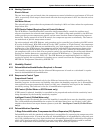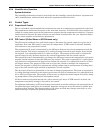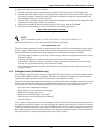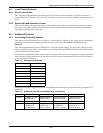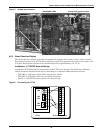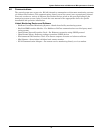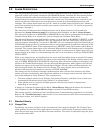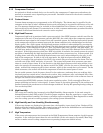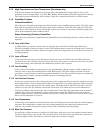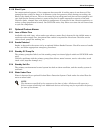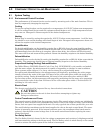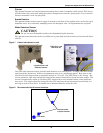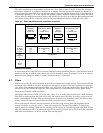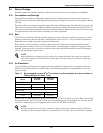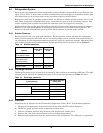
Alarm Descriptions
39
5.1.2 Compressor Overload
An optional tri-block overload device can be used for the compressor. Compressor overload may be
manual or automatic reset, depending on your model. Overload is located at the electric connection
box on the compressor.
5.1.3 Custom Alarms
Custom alarm messages are programmed at the LCD display. The alarms may be specified by the
customer at the time of order. Additional devices and wiring may be required at the factory or by oth-
ers. The message displayed may be included in this alphabetical list of alarms, or it may be custom-
ized text (for up to two alarms). If customized text is used, customer maintenance personnel should be
informed of the alarm function and corrective action required.
5.1.4 High Head Pressure
Compressor high head is monitored with a pressure switch. One SPDT pressure switch is used for the
compressor in the unit. If head pressure exceeds 360 PSIG, the switch opens the compressor contactor
and sends an input signal to the control. On a self-contained system, the head pressure switch located
at the compressor requires a manual reset and the alarm condition to be acknowledged on the front
display panel. On a split system, the high head pressure condition is acknowledged by pressing the
alarm silence button that will clear the alarm if the high head pressure condition no longer exists. On
a split system, if the compressor is off for 1 hour, the control goes into a special "cold start mode." In
the cold start mode on a call for cooling or dehumidification, the Liquid Line Solenoid Valve (LLSV) is
energized. If the high pressure switch does NOT trip within 10 seconds, the control returns to normal
operation of monitoring the high head pressure switch for three occurrences in a 12-hour period. It is
a rolling timer; and after the third high head alarm occurs and is acknowledged by the user, it will
lock off the compressor. If while in the cold start mode, the high head pressure switch DOES trip
within 10 seconds of the activation of the LLSV, the control does not annunciate the alarm. The con-
trol will turn off the LLSV and delay 10 seconds. The control will permit this occurrence two more
times or a total of three times. If on the fourth try the high head pressure switch trips within 10 sec-
onds, the control will annunciate the alarm, turn off the LLSV, wait for the user to acknowledge the
alarm, and hold the compressor off for three minutes, which is the normal short cycle control. On the
third occurrence, the control will lock the compressor off until the control power is reset.
On air cooled systems, check for power shut off to the condenser, condenser fans not working, defec-
tive head pressure control valves, closed service valves, dirty condenser coils, and crimped lines. Also,
make sure that when the compressor contactor is energized, the side switch on the contactor closes to
energize the control circuit on the air cooled condenser.
On water/glycol/GLYCOOL systems, check water regulating valves. Verify water/glycol flow (are
pumps operating and service valves open?). Is water tower or drycooler operating? Is the coolant tem-
perature entering the condenser at or below design conditions? Is relay R5 operating during cooling to
turn on the drycooler?
5.1.5 High Humidity
The return air humidity has increased to the High Humidity Alarm setpoint. Is the unit setup for
dehumidification (check DIP switch)? Check for proper setpoints. Does the room have a vapor barrier
to seal it from outdoor humidity? Are doors or windows open to outside air? Run diagnostics to make
sure the cooling system is working properly (the cooling system dehumidifies).
5.1.6 High Humidity and Low Humidity (Simultaneously)
If these two alarms are displayed at the same time, the humidity input signal is lost. Dashes will be
displayed for the humidity reading. The control system will deactivate humidification and dehumidi-
fication. Check for a disconnected cable or a failed sensor.
5.1.7 High Temperature
If the return air temperature has increased to the High Temperature Alarm setpoint, check for proper
setpoints. Is the room load more than the unit can handle (is the unit capacity too small)? Run diag-
nostics to make sure all cooling components are operating (compressor and/or valves).



